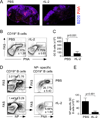Interleukin-2 inhibits germinal center formation by limiting T follicular helper cell differentiation
- PMID: 22464171
- PMCID: PMC3361521
- DOI: 10.1016/j.immuni.2012.02.012
Interleukin-2 inhibits germinal center formation by limiting T follicular helper cell differentiation
Abstract
T follicular helper (Tfh) cells promote T cell-dependent humoral immune responses by providing T cell help to B cells and by promoting germinal center (GC) formation and long-lived antibody responses. However, the cellular and molecular mechanisms that control Tfh cell differentiation in vivo are incompletely understood. Here we show that interleukin-2 (IL-2) administration impaired influenza-specific GCs, long-lived IgG responses, and Tfh cells. IL-2 did not directly inhibit GC formation, but instead suppressed the differentiation of Tfh cells, thereby hindering the maintenance of influenza-specific GC B cells. Our data demonstrate that IL-2 is a critical factor that regulates successful Tfh and B cell responses in vivo and regulates Tfh cell development.
Copyright © 2012 Elsevier Inc. All rights reserved.
Figures






Comment in
-
IL-2: fine-tuning the germinal center reaction.Immunity. 2012 May 25;36(5):702-4. doi: 10.1016/j.immuni.2012.05.005. Immunity. 2012. PMID: 22633457
References
-
- Almeida AR, Legrand N, Papiernik M, Freitas AA. Homeostasis of peripheral CD4+ T cells: IL-2R alpha and IL-2 shape a population of regulatory cells that controls CD4+ T cell numbers. J Immunol. 2002;169:4850–4860. - PubMed
Publication types
MeSH terms
Substances
Grants and funding
LinkOut - more resources
Full Text Sources
Other Literature Sources
Molecular Biology Databases
Miscellaneous

